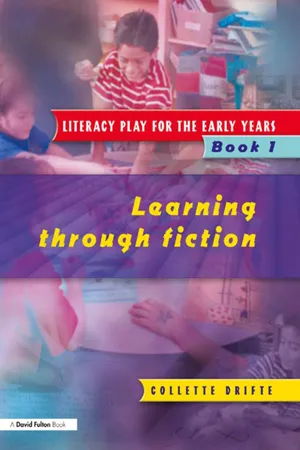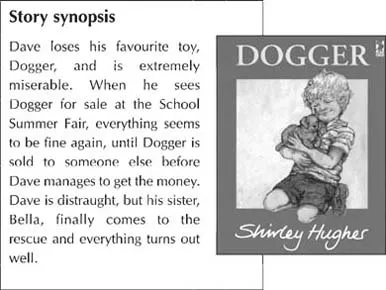
- 96 pages
- English
- ePUB (mobile friendly)
- Available on iOS & Android
About This Book
This series of books uses fiction, non-fiction and poetry texts, as well as phonics, as a basis to help young children in the Early Years develop their literacy skills. It brings together the early learning goals of the foundation stage and the national literacy strategy objectives, using structured play, games and fun activities to put across the relevant teaching points in an enjoyable way, while simultaneously nurturing a love of literature. Each book presents structured activities based around suggested focus texts. To help practitioners save time in planning and organizing, the materials needed and the preparation required for each session are described in detail. The activities have been designed to cater to different achievement levels, and can be adapted or added to according to the needs of individual children and settings. Follow-up activities are also suggested, to bring in wider aspects of the Early Learning Goals and the NLS objectives.
Elements of this book include exploring well-loved traditional stories and quality familiar modern stories by established authors; using the texts as a basis to focus on specific literacy goals and objectives; using the texts as a stimulus for games and play activities that help to teach literacy skills; planning and preparation for each literacy session, including materials needed and scripted sessions; ideas for working and playing with the whole group and smaller groups to consolidate the literacy skill; and extension ideas and activities.
Frequently asked questions
Information
CHAPTER 1
Dogger

Early learning goals from Curriculum guidance for the foundation stage, Communication, language and literacy:
- Interact with others, negotiating plans and activities and taking turns in conversation.
- Enjoy listening to and using spoken and written language, and readily turn to it in their play and learning.
- Sustain attentive listening, responding to what they have heard by relevant comments, questions or actions.
- Use language to imagine and recreate roles and experiences.
Objectives from the National Literacy Strategy (YR):
- To use a variety of cues when reading: knowledge of the story and its context, and awareness of how it should make sense grammatically.
- To use knowledge of familiar texts to re-enact or retell to others, recounting the main points in the correct sequence.
- To hear and identify initial sounds in words.
Materials needed
- Dogger by Shirley Hughes (Red Fox 1993), if possible use a Big Book version and have small book copies available as well
- Cuddly toy dog
- Flip-chart
- Marker pens
- Facial expressions sheet (see ‘Preparation’)
- The children’s name cards
- Card tubes (minimum of six)
- Coloured pens
Optional materials for other activities
- Several items beginning with ‘d’
- A selection of other familiar stories
- Sequencing story cards such as those produced by LDA
- ‘Junk’ equipment for making models for the Summer Fair
- Materials for making a frieze of the Summer Fair
- The children’s own favourite toys from home
- Cassette recorder/player, blank cassette, cuddly toys
- Other books by Shirley Hughes
Preparation
Introducing the text
- Ask someone to hold the cuddly toy dog for this session or alternatively put it on a seat beside you as you share the book.
- Look at the front and back covers of Dogger and talk about the illustrations. Ask the children how they think the little boy is feeling. How do they know? Do they have a favourite toy at home? Encourage a few of them to talk about why they love their toy.
- Read the ‘blurb’ on the back cover and talk about it. Who is Dave? Who is Dogger? Why is Dogger called Dogger? Does anybody know what ‘desolate’ means? What’s a garden fete? Has anyone been to one? What other names do the children know for a garden fete? For example, summer fair, summer fete, garden fair, etc.
- Share the story together, pointing to the text as you read. Pause occasionally and encourage the children to guess what the next word(s) might be. When you have finished, spend a few moments talking about the story. Do the children know how Dave felt at different stages in the story? For example, at the beginning, at teatime, at bedtime, during the night, during the Summer Fair, when he found Dogger on the stall, when Dogger was sold, when Bella swapped her bear for Dogger and when Dave went to bed that night.
- Ask the children to name some ‘feeling words’ – you could give them a start by reminding them of some of Dave’s feelings in the story. Enjoy making faces to show the different emotions. Encourage some of the children to draw a face on the flip-chart showing each feeling word. Make this fun!
- Do the children like this story? Encourage them to tell you why or why not. Were there any parts that made them feel sad, happy, scared, worried, etc.? What other feelings did they experience while listening to the story? Can they tell you why they felt these emotions?
Focus activities
| Group A: | Give the children copies of Photocopiable Sheet 1. Talk about each emotion and then encourage the children to complete each face to express the emotion word underneath it. Alternatively, the children could take turns to pose or model their own face to express that emotion while the others draw it. This will create more giggling than anything else! |
| Group B: | Allocate roles to the children and ask them to act the story of Dogger. Give one child the part of Dogger. Before beginning, spend a few minutes discussing how Dogger might have felt at being lost, sold and then returned to Dave. Do they act their play in sequence? When they have finished, give them the small books and let them follow the text while you read the story again from the Big Book. Are they confident enough to give a performance of their play for the whole group? |
| Group C: | Talk about the phonemes at the beginning of ‘Dogger’ and ‘Dave’. Do any of the children’s names start with ‘D’? Look at the children’s name cards and decide which begin with ‘D’. If none begin with ‘D’ can the children think of some? For example, Daniel, Derek, Daisy or Denise. Have some fun making up alliterative sentences with ‘d’ as the main phoneme: ‘Daisy dances daintily on a dandelion’ or ‘Daniel dropped into a dark dungeon’. |
| Group D: | Using the card tubes, together make finger puppets of Dave, Dogger, Bella, Mum, Dad, Joe and, if possible, some ‘extras’ for the Summer Fair. Draw and colour the features of each character on the tubes. Help the children to make up a play about how Dogger got lost and reunited with Dave, using the finger puppets. |
| Group E: | Make a second-hand toy stall like the one Dogger was sold from. Let the children make the labels and price tags for the toys – you may have to help them and/or scribe for them. Help them to extend their vocabulary by using words connected with the stall: ‘expensive’, ‘cheap’, ‘buy’, ‘sell’, ‘change’ (money), ‘spend’ and so on. |
| Group F: | Using the cuddly toy dog as Dogger, play a game of ‘Hide and Seek’, where each child takes a turn at hiding the toy and the others have to find it. Encourage the ‘hider’ to use preposition words as clues for the ‘seekers’, such as ‘near’, ‘close’, ‘far away’, etc. |
Other structured play activities
- Make a School Summer Fair. Together, look at Dogger again for ideas about the activities and stalls that the children might make for their Fair. Take time together to discuss and plan the layout. Let the children use as many different media as possible to make the things for the stalls. For example, plasticine, papier mâché, building blocks, boxes and cartons, dried foods and so on. Use the opportunity to work on simple money exchanges, numbers, practising some of the races in the hall or yard, choosing or designing and making fancy dress costumes for a parade.
- Ask the children to bring into school one of their own favourite toys – make sure they’re really ‘second favourite’ toys by checking with parents and that they are not part of crucial routines at home, to avoid a ‘Dave-at-bedtime-without-Dogger’ situation! “Work in smaller groups and talk about the toys: what they are, how the children play with them, why they love them so much, where they got them from, what they are made from and what they look like. Record their comments on tape. Encourage the children to paint a large picture of their own toys and make a wall display of the paintings. Help each child to write a label or caption for the picture. Let the children play the recording of their comments while they look at the display.
- Play a game of ‘I Spy’, looking for things that begin with ‘d’ in the room. Ask the children to collect any ‘d’ objects they can find and display them. Play ‘I Spy’ against the clock, seeing how many ‘d’ items the children can spot in one minute, two minutes, thirty seconds, etc. Can the children think of other ‘d’ words, not necessarily objects, for example, ‘Daddy’ or ‘do’?
- Make a large frieze of Dave’s School Summer Fair, using the double-page picture in Dogger as the basis. Before starting, discuss with the children the layout of the Fair in the picture and how it will relate to the frieze. Plan together how to transfer the stalls and games to the frieze. Encourage the children to suggest, experiment and predict, try out and then rethink if their ideas don ’t work out.
- Have some fun role-playing other familiar stories. Make sure the children are certain of the correct sequence and then experiment with the story out of order. How does it change the story? You could start by using traditional stories such as fairy-tales and then play around with other modern but familiar and popular stories used in the setting.
- Let the children play with sequencing story cards. Have some fun arranging them out of sequence and telling nonsense stories from the new (random) order. Use a stopwatch or egg timer to see how quickly the children can put the story back into the correct sequence.
- Leave the cassette player, recorded cassette and the book (if possible, several copies) in a corner and let th...
Table of contents
- Cover
- Title Page
- Dedication
- Table of Contents
- Acknowledgements
- Introduction
- 1 Dogger
- 2 The Most Obedient Dog in the World
- 3 Whiff or how the beautiful big fat smelly baby found a friend
- 4 Jack and the Beanstalk
- 5 Guess How Much I Love You
- 6 Honda's Surprise
- 7 Morag and the Lamb
- 8 Dear Daddy
- 9 Can't You Sleep, Little Bear?
- 10 Paddington Goes to Hospital
- 11 A Letter to Father Christmas
- Observation and assessment for speaking and listening
- Observation and assessment for reading and writing